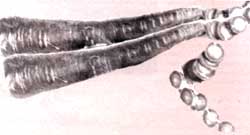Oily hopes
 A study conducted by a team of scientists belonging to the Regional Research Laboratory (RRL), under the Council of Scientific and Industrial Research in Thiruvananthapuram, shows that the use of red palm oil (RPO) could help combat vitamin A deficiency, especially in pre-school children. The study formed part of a multi-centre project and similar studies were conducted in Coimbatore, Hyderabad and New Delhi. "Considerable improvement in the vitamin A status of pre-school children in terms of their serum beta-carotene levels and clinical symptoms were observed in our study," claims C R Arumughan, project leader and head, Oil Seeds Research Division of RRL, Thiruvananthapuram.
A study conducted by a team of scientists belonging to the Regional Research Laboratory (RRL), under the Council of Scientific and Industrial Research in Thiruvananthapuram, shows that the use of red palm oil (RPO) could help combat vitamin A deficiency, especially in pre-school children. The study formed part of a multi-centre project and similar studies were conducted in Coimbatore, Hyderabad and New Delhi. "Considerable improvement in the vitamin A status of pre-school children in terms of their serum beta-carotene levels and clinical symptoms were observed in our study," claims C R Arumughan, project leader and head, Oil Seeds Research Division of RRL, Thiruvananthapuram.
About 2,700 children were involved in the study which started in 1993. 'these children were drawn from 80 balawadis administered by Vivekananda Kendra situated in Nagercoil, Valliyoor, Kovilpatti, and Paramkudi districts of Tamilnadu. They were divided into experimental and control groups. About five grammes of RPO was fed to the experimental group along with their noon meal, while the control group received their regular meal seasoned with groundmit oil. In the case of vitamin A deficiency, Bitot's spots in the eyes was accepted as clinical evidence. I he study revealed that a considerable reduction in the prevalence of Bitol's spots was observed in the experimental group compared to the control group. Most of the disappearance occurred during the first six months of feeding. Also, a significant increase in the serum beta-carotene levels of the experimental group was observed, which was attributed to the high beta-carotene levels of RPO. The importance of beta-carotene lies in the fact that it is the precursor of vitamin A. in the human body, it is converted into Vitamin A.
RPO has been identified as the biggest natural source of alpha-and beta-carotenes - 500-700 parts per million (PPM) - and it contains 30 times more carotenes than carrots. RPO is also a rich source of tecopherols and tocotrienols (800 PPM), and recent findings show that these compounds possess antioxidant properties.
On an average, four tonne (t) of oil could be obtained from one ha of oil palm as against 0.5-1.5 t from other conventional oil crops. It is estimated that about five lakh ha could be brought under oil palm during the coming 20 years in India. According to Arumughan, further RPO studies will investigate the reappearance of Bitot's spots in some case studies.
